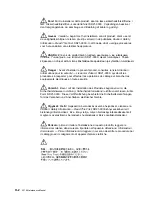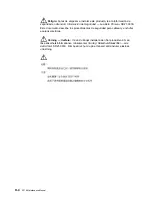
the final destination. A benefit of spoofing is the
prevention of end-to-end session timeouts.
SRC. System reference code.
STM-1. Synchronous transport module-1.
SW. Switch (module).
SWRD. Switch redrive (module).
synchronous. (1) Pertaining to two or more
processes that depend upon the occurrence of specific
events such as common timing signals. (T)
(2) Occurring with a regular or predictable time
relationship.
Synchronous Data Link Control (SDLC). A discipline
conforming to subsets of the Advanced Data
Communication Control Procedures (ADCCP) of the
American National Standards Institute (ANSI) and
High-level Data Link Control (HDLC) of the International
Organization for Standardization, for managing
synchronous, code-transparent, serial-by-bit information
transfer over a link connection. Transmission
exchanges may be duplex or half-duplex over switched
or nonswitched links. The configuration of the link
connection may be point-to-point, multipoint, or loop. (I)
Contrast with
binary synchronous communication
(BSC).
synchronous optical network (SONET). A US
standard for transmitting digital information over optical
interfaces. It is closely related to the synchronous
digital hierarchy (SDH) recommendation.
system. In data processing, a collection of people,
machines, and methods organized to accomplish a set
of specific functions. (I) (A)
Systems Network Architecture (SNA). The
description of the logical structure, formats, protocols,
and operational sequences for transmitting information
units through, and controlling the configuration and
operation of, networks. The layered structure of SNA
allows the ultimate origins and destinations of
information, that is, the end users, to be independent of
and unaffected by the specific SNA network services
and facilities used for information exchange.
T
TCP. Transmission Control Protocol.
TCP/IP. Transmission Control Protocol, Internet
Protocol.
TDM. Time division multiplexing.
Telnet. In TCP/IP, an application protocol that allows a
user at one site to access a remote system as if the
user’s display station were locally attached. Telnet
uses the Transmission Control Protocol as the
underlying protocol.
TFTP. Trivial File Transfer Protocol.
time division multiplexing (TDM). See
channelization.
TN3270. An informally defined protocol for transmitting
3270 data streams over Telnet.
TN3270. An informally defined protocol for transmitting
3270 data streams over Telnet.
token. (1) In a local area network, the symbol of
authority passed successively from one data station to
another to indicate the station temporarily in control of
the transmission medium. Each data station has an
opportunity to acquire and use the token to control the
medium. A token is a particular message or bit pattern
that signifies permission to transmit. (T) (2) In LANs, a
sequence of bits passed from one device to another
along the transmission medium. When the token has
data appended to it, it becomes a frame.
token ring. (1) According to IEEE 802.5, network
technology that controls media access by passing a
token (special packet or frame) between media-attached
stations. (2) A FDDI or IEEE 802.5 network with a ring
topology that passes tokens from one attaching ring
station (node) to another. (3) See also
local area
network (LAN).
Transmission Control Protocol (TCP). A
communications protocol used in Internet and in any
network that follows the U.S. Department of Defense
standards for internetwork protocol. TCP provides a
reliable host-to-host protocol between hosts in
packet-switched communications networks and in
interconnected systems of such networks. It assumes
that the Internet protocol is the underlying protocol.
Transmission Control Protocol/Internet Protocol
(TCP/IP). A set of communications protocols that
support peer-to-peer connectivity functions for both local
and wide area networks.
Transmission Control Protocol/Internet Protocol
(TCP/IP). A set of communication protocols that
support peer-to-peer connectivity functions for both local
and wide area networks.
transparent bridging. In LANs, a method for tying
individual local area networks together through the
medium access control (MAC) level. A transparent
bridge stores the tables that contain MAC addresses so
that frames seen by the bridge can be forwarded to
another LAN if the tables indicate to do so.
Glossary
X-9
Содержание Nways 2216
Страница 1: ...2216 Nways Multiaccess Connector ÉÂÔ Service and Maintenance Manual SY27 0350 02 ...
Страница 2: ......
Страница 3: ...2216 Nways Multiaccess Connector ÉÂÔ Service and Maintenance Manual SY27 0350 02 ...
Страница 8: ...vi 2216 Maintenance Manual ...
Страница 10: ...Common Tasks and the IBM 2216 Library viii 2216 Maintenance Manual ...
Страница 45: ...6 Remove the adapter from its location Chapter 2 Removal and Replacement Procedures 2 15 ...
Страница 60: ...3 6 2216 Maintenance Manual ...
Страница 84: ...4 24 2216 Maintenance Manual ...
Страница 104: ...A 2 2216 Maintenance Manual ...
Страница 106: ...Assembly 1 Final Assembly 2216 Model 400 B 2 2216 Maintenance Manual ...
Страница 110: ...B 6 2216 Maintenance Manual ...
Страница 114: ...1 2 3 4 5 6 7 8 9 10 Figure C 1 Power Cord Plugs by Country C 4 2216 Maintenance Manual ...
Страница 138: ...F 12 2216 Maintenance Manual ...
Страница 150: ...UWAGA Całkowicie wypełnione urządzenie IBM 2216 waży około 43 1 kg H 6 2216 Maintenance Manual ...
Страница 164: ......
Страница 167: ......
























